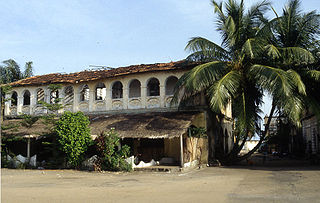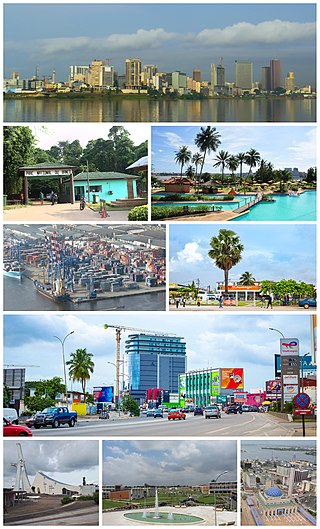Christianity in Ivory Coast is practiced by 39.8% of the population (2021 data) which is an increase since 2014 when it was 33.9% of the population. [1] [2] It dominates the south of the country.
| Christianity by country |
|---|
 |
| |
Christianity in Ivory Coast is practiced by 39.8% of the population (2021 data) which is an increase since 2014 when it was 33.9% of the population. [1] [2] It dominates the south of the country.
About 17% of the population is Roman Catholic. [1] Roman Catholicism made a brief appearance in Ivory Coast in the mid-seventeenth century and reappeared two centuries later when French missionaries began to work among the Agni. [3] The first African Roman Catholic mission in Ivory Coast was established in 1895, and the first African priest was ordained in 1934. [3] In the 1980s, the Roman Catholic Church operated seminaries and schools throughout the country. [3] Although Ivory Coast is officially a secular state, the president expressed pride in Abidjan's large Roman Catholic cathedral and alone funded construction of a basilica at Yamoussoukro, his birthplace, by 1990. [3] Some villages have also adopted patron saints, whom they honor on both secular and religious holidays. [3]
In 2021 about 2.3% of the population described themselves as Evangélique (Protestant) or as Methodist. [1] Also 0.5% of the population described themselves as following Harrism. [1] Other forms of Christianity were followed by 20% of the population in 2021; a sharp rise from the 2014 figure of 2.2%. [1] [2]
The largest Protestant religion as of the mid-1980s was Harrism, begun in 1914 by William Wade Harris, a Liberian preacher who proselytized along the coast of Ivory Coast and Ghana. [3] Harris set an example for his followers by leading a simple life and eschewing conspicuous wealth. [3] He condemned the use of amulets and fetishes as idolatry, and he preached against adultery, theft, and lying. [3] His was a simple, fairly austere form of Christianity, which was open to Roman Catholics and Protestants and did not preach open defiance of colonial authority. [3]
In 1915 Harris was expelled from the region by an uneasy colonial governor, an action that revitalized his church, leaving dozens of small "Harrist" churches along the coast. [3] A decade later, Methodist missionaries made contact with Harris and attempted to continue his work among the lagoon peoples. [3] Harris succeeded in part because of his ethnic background—he was African but not Ivoirian—but also because he converted women as well as men—a practice that had been scorned by earlier Christian missionaries who failed to recognize the impact of matrilineal descent on an individual's spiritual life. [3] Harrism was subsequently recognized as a branch of Methodism. [3] Most widely recognized among the syncretic religions of the country are numerous offshoots of Harrism along the coast, where new prophets, preachers, and disciples blend traditional beliefs, Harrism, and modern-day political advice to help deal with the problems of everyday life. [3]
The Church of Jesus Christ of Latter-day Saints claims more than 43,000 members in 211 wards or branches in Cote d'Ivoire. They have 27 family history centers in Cote d'Ivoire. A temple is being built in Abidjan, to be completed in 2021 or 2022. [4]

Yamoussoukro is the de jure capital of Ivory Coast and an autonomous district. As of the 2014 census, Yamoussoukro is the fifth most populous city in Ivory Coast with a population of 212,670. Located 240 kilometers (150 mi) north-west of Abidjan, the district of Yamoussoukro covers 2,075 square kilometers (801 sq mi) among rolling hills and plains.
Human arrival in Ivory Coast has been dated to the Upper Paleolithic period, or at the minimum, the Neolithic period based on weapon and tool fragments, specifically polished shale axes and remnants of cooking and fishing. The earliest known inhabitants of Côte d'Ivoire left traces scattered throughout the territory. Historians believe these people were all either displaced or absorbed by the ancestors of the present inhabitants. Peoples who arrived before the 16th century include the Ehotilé (Aboisso), Kotrowou (Fresco), Zéhiri, Ega, and Diès (Divo).

Ivory Coast, officially the Republic of Côte d'Ivoire, also known as Côte d'Ivoire, is a country on the southern coast of West Africa. Its capital is Yamoussoukro, in the centre of the country, while its largest city and economic centre is the port city of Abidjan. It borders Guinea to the northwest, Liberia to the west, Mali to the northwest, Burkina Faso to the northeast, Ghana to the east, and the Gulf of Guinea to the south. Its official language is French, and indigenous languages are also widely used, including Bété, Baoulé, Dioula, Dan, Anyin, and Cebaara Senufo. In total, there are around 78 different languages spoken in Ivory Coast. The country has a religiously diverse population, including numerous followers of Islam, Christianity, and traditional faiths like Animism.

Grand-Bassam is a town in southeastern Ivory Coast, lying east of Abidjan. It is a sub-prefecture of and the seat of Grand-Bassam Department; it is also a commune. During the late 19th century, Grand-Bassam was briefly the French colonial capital of Ivory Coast. Because of its outstanding examples of colonial architecture and town-planning, and the juxtaposition of the colonial town with a traditional Nzema village, the historic center of Grand-Bassam was designated a UNESCO World Heritage Site in 2012.
Christianity in Angola has existed since 1491. Today 80% of Angolans practise some form of Christianity.

Bernard Yago was an Ivoirian Cardinal of the Catholic Church. He served as Archbishop of Abidjan from 1960 to 1994 and was made cardinal in 1983.

Christianity is the predominant religion in the Democratic Republic of the Congo, with Catholicism and Protestantism being its main denominations.

Religion in Ivory Coast is diverse, with no particular religion representing the majority of the population. According to the 2021 census, Islam is professed by 42.5% of the total population, while adherents of Christianity represented 39.8% of the population. In addition, 12.6% of Ivorians reported to be non-religious and 2.2% claimed to follow Animism.

Women in Ivory Coast formed less than half the country's population in 2003. Their social roles and opportunities have changed since the time of French colonialism.

Abidjan is the largest city and the economic capital of the Ivory Coast. As of the 2021 census, Abidjan's population was 6.3 million, which is 21.5 percent of overall population of the country, making it the sixth most populous city proper in Africa, after Lagos, Cairo, Kinshasa, Dar es Salaam, and Johannesburg. A cultural crossroads of West Africa, Abidjan is characterised by a high level of industrialisation and urbanisation. It is also the most populous Dioula-speaking and French-speaking city in Africa.

William Wadé Harris was a Liberian Grebo evangelist, who preached in Liberia, Côte d'Ivoire and Ghana. He has been described as the "most extraordinary one man evangelical crusade that Africa has ever known" and is considered one of the originators of today's prosperity gospel.

Ambrose Madtha was the Roman Catholic archbishop and the Nuncio to Ivory Coast. He was the sixth Indian to become an Apostolic Nuncio.

The Church of Jesus Christ of Latter-day Saints in Ivory Coast refers to the Church of Jesus Christ of Latter-day Saints and its members in Ivory Coast. At year-end 1989, there were fewer than 200 members in Ivory Coast. In 2022, there were 60,162 members in 257 congregations.
The following is a timeline of the history of the city of Abidjan, Ivory Coast.
The doctrines and practices of modern Pentecostalism placed a high priority on international evangelization. The movement spread to Africa soon after the 1906 Azusa Street Revival in Los Angeles.

Canada–Ivory Coast relations are the diplomatic relations between Canada and Ivory Coast. Both nations are members of the Organisation internationale de la Francophonie.
The Union of Missionary Baptist Churches in Ivory Coast is a Baptist Christian denomination, affiliated with the Fédération Évangélique de Côte d’Ivoire and the Baptist World Alliance, in the Ivory Coast. The headquarters is in Abidjan.

France–Ivory Coast relations are the diplomatic relations between the French Republic and the Republic of Ivory Coast. Both nations are members of the Organisation internationale de la Francophonie and the United Nations.

The Church of Jesus Christ of Latter-day Saints in Cameroon refers to the Church of Jesus Christ of Latter-day Saints and its members in Cameroon. The first branch was organized in Yaoundé in 1992. In 2022, there were 2,721 members in 15 congregations.
Mohammed Sanogo is an Ivorian pastor, author and missionary from Ivory Coast. Married to Liliane Sanogo since in 2000, he is the founder and general overseer of the Messages De Vie Ministry and of Vases d'honneur Church, based in Abidjan. He is considered as a "prototype of the modern Pentecostal prophet".